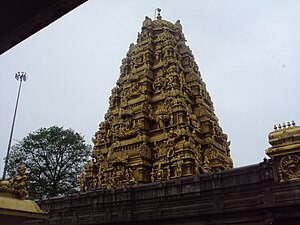Shikhara

Shikhara (
In South India, the equivalent term is vimana; unlike the shikhara, this refers to the whole building, including the sanctum beneath. In the south, shikhara is a term for the top stage of the vimana only, which is usually a dome capped with a finial;[3] this article is concerned with the northern form. The southern vimana is not to be confused with the elaborate gateway-towers of south Indian temples, called gopuram, which are often taller and more prominent features in large temples.
Forms
Shikhara can be classified into three main forms:[4]
- Latina. The latina shikhara has four faces, which may include projections or ratha within each face. All the elements run smoothly up the face in a curve. They are also sometimes called "homogeneous" shikhara, as opposed to the next two types, which may be called "heterogeneous".[5] It is the most common form of a shikara.[6]
- Sekhari. The sekhari shape has added engaged (attached) sub-spires or spirelets called urushringa, echoing the main shape. These may run up most of the face. There may be more than one size of these, sometimes called secondary and tertiary. Tertiary spirelets are typically near the ends of the face or on the corners.[7]
- Bhumija. The tower has miniature spires, in horizontal and vertical rows, all the way to the top,[8] creating a grid-like effect on each face. The tower is generally less strongly vertical in overall shape, often approaching a pyramidal shape. This shape is mainly found in the northern Deccan and West India.[7]
History
The early history of the Hindu shikhara is unclear,
By at least 600 CE in Odisha,[15] and perhaps somewhat later in the Deccan Plateau and West India,[16] the Latina form of the shikhara is well-established, with an amalaka disk-stone at the top, and then a kalasha urn. There is often a sukanasa feature over the entrance door.[17]
The forms with smaller subsidiary spires begin in the 10th century,[18] and from then on tend to predominate. The Khajuraho Group of Monuments has several early forms from early in the century, though Latina ones reappear after about 1050, in examples like the Vamana Temple.[19] The bhumija spire probably first appears around 1000-1025, with other temples begun in the 1050s, such as the Shiv Mandir, Ambarnath.[20]
Major styles

Shikharas form an element in the many styles of
- The Nagara style is more prevalent in northern India, within which, the shikhara is recognized as a high curved shape. In the north-east, the local term Rekha Deula is the sanctum and the tower over it; gandi is also a term for the upper tower only, equating to shikhara. The curve is also very slight until the top, and the amalaka rather large, typically supported by four lion sculptures facing out.[21] Of the many temples in Bhubaneswar, only the Rajarani Temple has significant spirelets.[22]
- The Chalukyatemples. In the vesara style, the tower moves towards a lower conical shape, with highly ornate carving.
- The Dravidian style is prevalent in southern India, in which the equivalent of the shikhara is the vimana. The superstructure above the sanctum is typically more like a four-sided pyramid in overall shape, consisting of progressively smaller storeys of pavilions (talas), with a profile that is normally straight than curved. The Dravidian superstructure is generally highly ornate.
In every style of shikhara/vimana, the structure culminates with a "kalasha", or urn for offerings, or water-pot, at its peak.
-
Nagara shikhara of Rameshwar Temple in Bhubaneswar
-
DravidianMurudeshwaraTemple
-
Vesara style ofChennakesava Temple, Somanathapura. Towers are in 16 pointed star plan.
See also
- Meru tower
- Vimana (architectural feature)
- Hindu temple architecture
- Balinese temple
- Stupa
- Kadamba Shikhara
Notes
- ^ a b "Archived copy" (PDF). Archived from the original (PDF) on 2016-03-03. Retrieved 2012-11-03.
{{cite web}}: CS1 maint: archived copy as title (link) - ^ "Shikhara". Encyclopædia Britannica. Retrieved 4 August 2015.
- ^ Harle, 167
- ^ Hardy, 270
- ^ Volwahsen, Andreas (1968). Inde bouddhique, hindoue, jaïn (Architecture universelle ed.). Fribourg (Suisse): Office du Livre. pp. 143–147.
- ^ Hardy, 270-272
- ^ a b Hardy, 273-274
- ^ "bhumija (Indian architecture)". Encyclopædia Britannica. Archived from the original on 11 November 2007. Retrieved 2007-12-30.
- ^ a b c Le Huu Phuoc, Buddhist Architecture, pp.238-248
- ^ Harle, 111, 136-139
- ^ Harle, 201; Michell, 228-229
- ^ Sarkar, Gurudas; Shepherd, Charles; Bourne, Samuel (1922). "Notes on the History of Shikhara Temples". Rupam - an Illustrated Quarterly Journal of Oriental Art (10).
- ^ Buddhist Architecture, Le Huu Phuoc, Grafikol 2009, p.242
- ISBN 9781118007396.
- ^ Harle, 158-159
- ^ Harle, 136-139, 166-171
- ^ Harle, 140
- ^ Harle, 219
- ^ Harle, 232-235
- ^ Harle, 230-232
- ^ Harle, 246
- ^ Harle, 246, 249
References
- ISBN 8170173124, 9788170173120, google books
- Harle, J.C., The Art and Architecture of the Indian Subcontinent, 2nd edn. 1994, Yale University Press Pelican History of Art, ISBN 0300062176
- Michell, George (1988), The Hindu Temple: An Introduction to Its Meaning and Forms, University of Chicago Press, ISBN 978-0226532301





